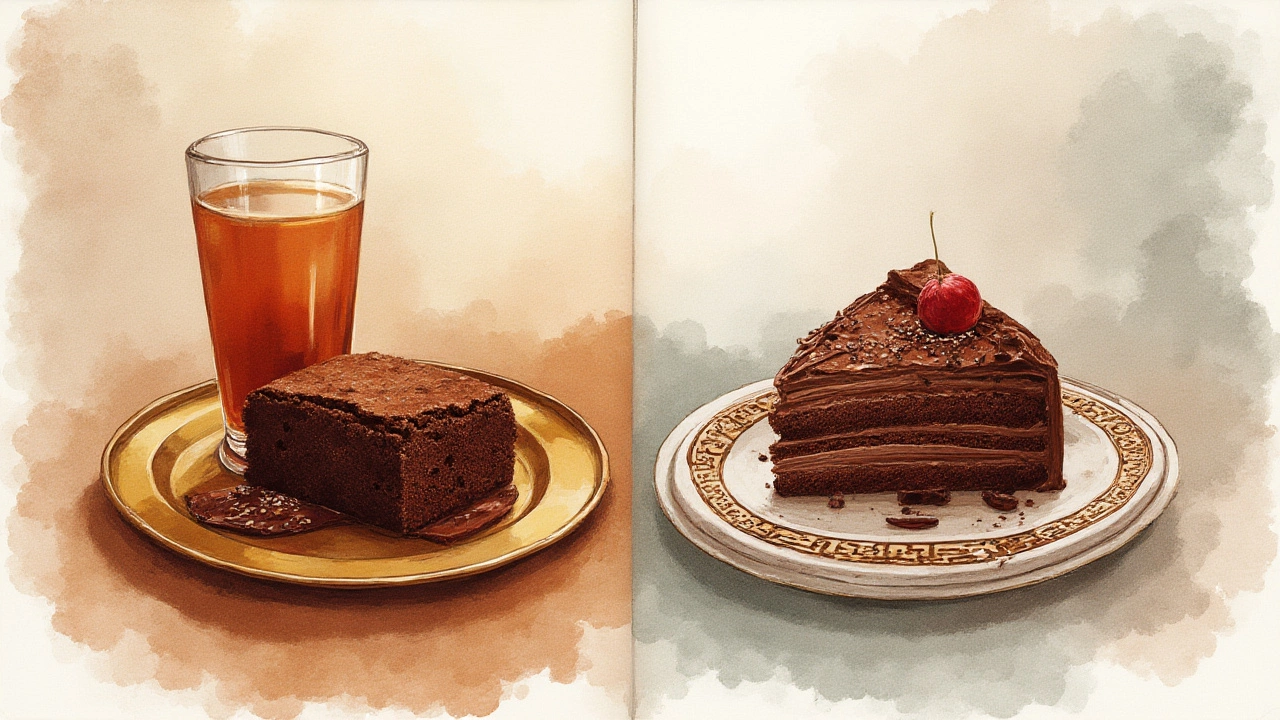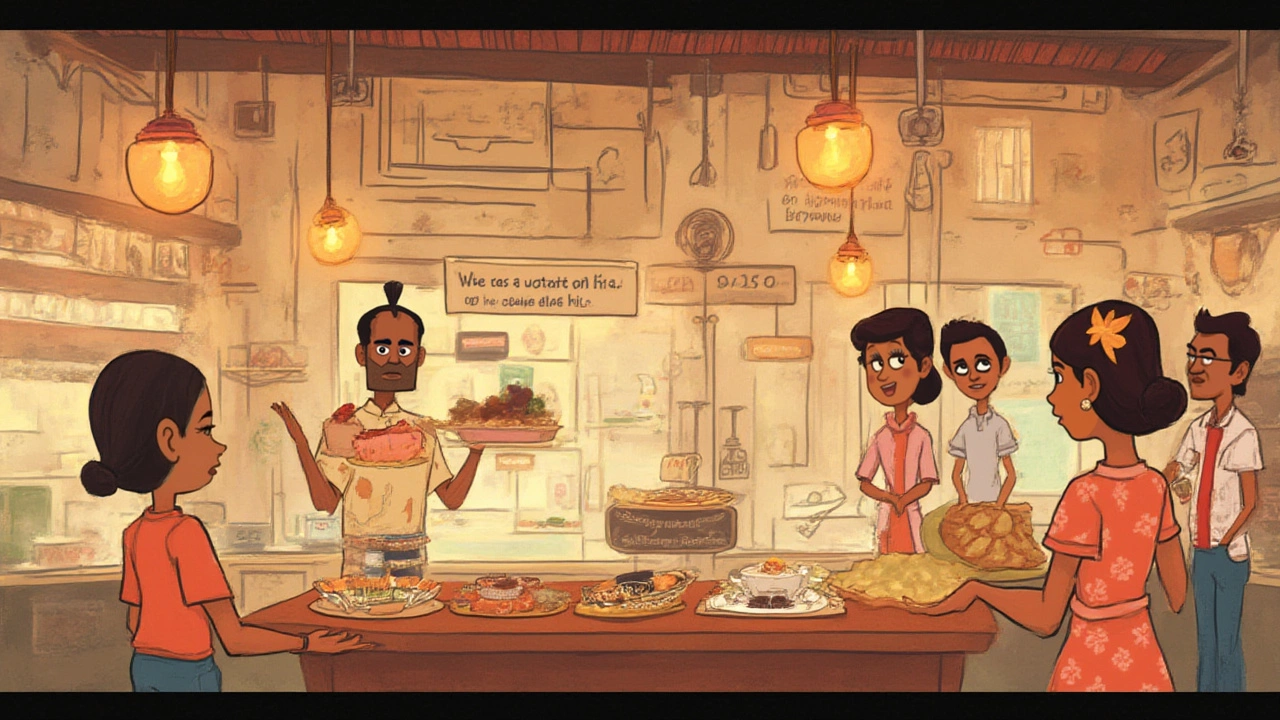Picture this: you just pulled a tray of brownies from the oven (that unmistakable smell radiates through the house), and someone asks, “So, are these really just small cakes?” Suddenly, you’re stuck between recipes and reality, wondering which dessert box your fudgy squares actually fit in. The line between brownies and cake isn’t as crystal-clear as most of us think. If you’ve ever stood in your kitchen, spatula in hand, feeling personally attacked by the phrase “cake-like brownie,” keep reading—you’re not alone.
The Birth and Mystery of Brownies
The story of brownies starts in America, and nothing says classic comfort quite like a chewy, chocolate-loaded square. Back in the late 19th century, brownies first popped up in American cookbooks. Historians trace the earliest published recipe to Fannie Farmer’s 1896 revision of the Boston Cooking-School Cook Book, but back then, we’re not talking about today’s chocolatey version—it was lighter, more like a blondie, before cocoa swaggered onto the scene. So, what made them brownies? The notable switch was adding chocolate and ditching any mention of cake pans or elaborate decorating.
Here comes the twist: that first reference to "brownie" wasn’t even chocolate but molasses and nuts. By the early 1900s, chocolate took over, launching brownies into dessert stardom. This coincided with the rise of American home baking traditions, where practicality met indulgence. The home baker wanted a sweet treat that was simple, portable, and didn’t need frosting. Enter: the brownie.
Unlike cakes, usually designed to be light, airy, and layered, brownies arrived with a chewy or fudgy, almost dense intention. And that’s never changed. The real kicker is, brownies straddle two worlds: the handheld ease of a bar cookie, the satisfying depth of a chocolate cake, but still uniquely themselves. One study at the Smithsonian’s National Museum of American History highlights how brownies grew up alongside modern American kitchens, from boxed mixes to family recipes—each tied to nostalgia, holiday plate swaps, and informal gatherings.
There’s a certain comfort in that slightly cracked top, a hallmark that separates a proper brownie from fluffy cake squares. In America, the first bakery recipes appeared just a year or two after commercial chocolate became widely available, and the rest is history—both sweet and sticky.
Cake or Brownie? Ingredients and Chemistry
The basic building blocks for both desserts don’t look too different on paper: flour, sugar, eggs, fat, and some rising agent. But the difference in how you use those building blocks creates the magic. Want a side-by-side? Check out the table below:
| Feature | Traditional Brownie | Chocolate Cake |
|---|---|---|
| Fat Source | Butter or oil (more fat) | Butter or oil (less than brownies) |
| Sugar | Granulated or brown sugar | Granulated white sugar |
| Leavening | Very little, often none or just eggs | Baking powder/soda for fluffy rise |
| Texture | Dense, chewy or fudgy | Light, fluffy, spongy |
| Mixing Method | Minimal, to avoid air | Cream sugar/butter, whip for air |
| Serving Style | Cut into squares, handheld | Sliced from round or rectangle pan |
It’s not only what you put in, but how you mix it. Classic brownie recipes use twice as much fat as cake mixes. In brownies, the butter (or sometimes oil) acts as an anchor, trapping sugar and chocolate together, giving that dense bite. Cakes want a different finish—think air and rise. That’s where baking powder and longer whipping time come into play.
If you beat brownie batter too long, or add too much baking powder, you’ll pull the texture toward cake territory without meaning to. The best brownies start with melted butter (not creamed), and you only stir until combined. The more you work the batter, the cakier and lighter it gets. A lot of home bakers use this rule-of-thumb: “Less fuss, better brownie.”
Egg proportion also shapes the dessert. More eggs? Greater structure, and sometimes a more cake-like result. Less flour means a fudgier square. Want a pro tip? Add a spoonful of espresso powder to deepen the chocolate flavor, or a pinch of sea salt to round out the sweetness.

Texture: The Real Decision Maker
If someone handed you a blindfolded taste test—one chewy, fudgy with a shiny top, and one fluffy and full of tiny holes—you’d instantly know which is which. Brownie lovers hunt for the satisfying density, a sort of half-cooked chocolate truffle interior, compared to the “cloud” of a chocolate cake slice.
“Brownies aren’t cakes. They’re dense, unpretentious, and deeply chocolatey. Cake fluffiness only gets in the way.” That’s from a baker at New York’s iconic Magnolia Bakery, quoted in a Food & Wine feature about the science of texture. The brownie’s classic “skin” on top—shiny and crackled—comes from rapidly beating sugar into the eggs, almost like a thin meringue. Cakes never have this.
If you poke your finger into a fresh brownie, you’ll find resistance, followed by a smooth, almost fudgy separateness. With cake, it springs straight back—thanks to millions of air bubbles trapped during mixing and leavening. Even edges matter. Brownie corners? Crisp and caramelized. Cake edges? Soft, just a vessel for more cake inside. Brownies, at that level, are almost like the chewy bar cookies of your chocolate dreams.
Chewy brownies (less flour, more butter), cakey brownies (more eggs and maybe even a smidge of baking powder), and the outlier, the “blondie” (no chocolate, just vanilla and brown sugar)—none of them ever really cross over into cake territory, unless something’s gone wrong.
Baking pans shape the outcome too. Thick, metal square pans give crispy sides and gooey centers. Glass dishes cook more gently, so you risk dry edges. Many bakers line their pans with baking paper for easy lift-out and photo-worthy squares. Don’t stack ’em too high in the pan or your brownie risks getting too close to a cake’s crumb.
Texture is so important that it’s inspired heated debates on Reddit, Instagram, and even on late-night TV. “If the middle isn’t gooey and dense, you’re eating chocolate cake, mate,” my local barista told me just last week while handing off a stack of the shop’s signature brownies on Lygon Street. She’s got a point.
Cakes and Brownies Around the World
Brownies might be American by birth, but they’ve conquered dessert menus across continents. Take a walk through a Melbourne bakery and you’ll find everything from gluten-free raspberry swirl brownies to elaborate triple-chocolate walnut squares. But you’ll rarely, if ever, see them labeled “brownie cake”—the name stands alone.
The closest cousin in Europe is something like the Swedish kladdkaka—a sticky chocolate cake so dense, it could almost pass for a brownie. In France, gateau au chocolat sometimes gets served by the square, fudgy and rich, but just isn’t the same as what we stack on Aussie brunch counters with a dusting of powdered sugar. In the UK, “traybakes” are popular, but brownies remain in their own slot.
Baking traditions shape this too. Americans tend to use cocoa powder, lots of butter, and sometimes leave nuts out entirely. Aussies love packing brownies with macadamias, white chocolate chunks, or swirling in peanut butter. In places like Japan, you might find matcha-infused brownies or those loaded with dried fruit. Some Indian home bakers skip eggs and use yogurt or condensed milk for a vegetarian twist.
The one universal fact? No matter where you are, if you order a brownie, no one expects a slice of cake. Restaurants keep it simple, serving warm brownies with a scoop of ice cream. Birthday cakes, though? Even with chocolate icing, they stay firmly in the cake camp.
This divide isn’t about snobbery—it’s just about expectations. You wouldn’t trade a chewy, edge piece of brownie for the cloud-like fluff of a well-made sponge cake on your birthday, would you? Each has its place. And honestly, brownies are easier to bake at altitude, cope better with mix-ins, and repel dryness better than most cakes could ever hope to.

Baking Tips for Perfect Brownies Every Time
If this whole debate has inspired you to start baking, here’s what separates a “brownie” from a sneaky chocolate cake square, and how to avoid the biggest rookie mistakes.
- Use real chocolate—not just cocoa powder—for depth. Good-quality, high-cacao dark chocolate gives a grown-up edge. Don’t bother with “compound” blocks meant for melting; pure is best.
- Don’t over-mix. Once you add flour, stir only until you see no more flour streaks. Over-mixing = more gluten = cakier brownies. Less is more!
- Let the batter rest for 10–15 minutes at room temperature before baking. This helps hydrate the flour and results in an even fudgier texture.
- Opt for metal pans if you can. Glass or ceramic hold heat longer, risking burnt corners and a dry center.
- Cool completely before slicing. As tempting as they smell, hot brownies fall apart. Pop your tray in the fridge for clean, Insta-ready squares.
- Don’t skip the salt. Just a half-teaspoon in the batter, plus another tiny sprinkle on top, brings out the chocolate flavor and prevents a one-dimensional, sweet-only result.
- Mix-ins like nuts, chocolate chips, raspberries, or even swirls of caramel are your friend. Just keep overall batter thickness stable, so you don’t mess with the bake time.
- Testing for doneness? Insert a toothpick—look for a few moist crumbs, not completely clean or too wet. If it’s bone-dry, you’ve wandered straight into cake zone.
- For vegan versions: swap eggs for aquafaba (chickpea brine) or flaxseed meal, and use coconut oil instead of butter. Plenty of Melbourne bakeries serve some of the best vegan brownies you’ll ever try.
- Want gluten-free? Substitute plain flour with a blend of almond meal and gluten-free flour. You might even get a richer, gooier result.
As culinary expert Harold McGee once said:
"The fundamental difference between brownies and cake comes down to the ratio of fat to flour and the handling of the batter. More fat and less mixing means a fudgier treat with a closer texture and that signature glossy crust."
One last tip—if someone ever claims your brownies are “too dense,” just tell them: that’s the point! No one ever changed the world with a fluffy brownie.